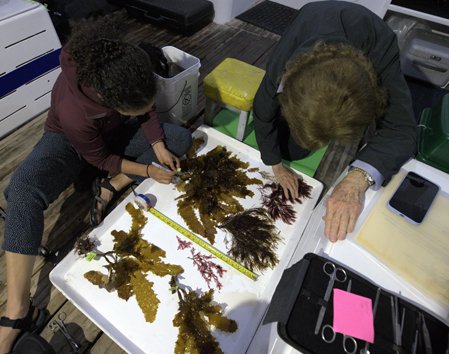Author: Salome Buglass, collaborating scientists of CDF's deep.icean exploration program and former CDF staff member
Kelps are giant, brown algae that look a lot like plants, but actually belong to the Protist Kingdom, so they are not even closely related. However, much like trees, kelp can form vast undersea canopies, called kelp forests, teeming with marine file, feeding, breeding and finding refuge there. Kelps are cold water species that need nutrients, light and a hard seafloor to latch on to with their holdfasts (a rootlike system). This is why kelp forests are almost exclusively found in higher, colder latitudes. However, there are some exceptions, and one of them is in the Galápagos, where the first tropical kelp species, Eisenia galapagensis, was recorded back in 1930s.
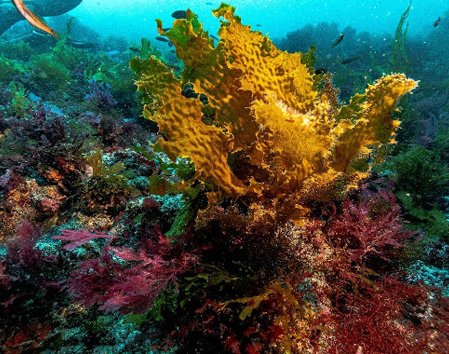
While the Galápagos Archipelago lies right on the equator where the climate is tropical, various cold-water currents up well on the coastlines of the most western and southeastern islands. This means that many cold-water species such as penguins, sea lions and kelps were able to make this island their home. Eisenia galapagensis is endemic, meaning it is only found in this location. It is also classified as endangered, having been almost entirely wiped out by the 1982-1983 El Niño event. Since then, Galápagos kelps have rarely been spotted, and then only in the colder and deeper waters (>20m) of the western region of the archipelago. There are few extant specimens to study, and not much scientific data was collated, so little is known about Galápagos kelp biology and the habitats they form.
When I first joined the Charles Darwin Research Station team, I learned about the enigma of the endemic kelp. So, when I started surveying seamount habitats at mesophotic depths (40-200m) using ROVs in 2018, never did I imagine I would discover an extensive kelp stand at a depth of 40-70m covering the summit of a small seamount located in the central region of the archipelago. I was gob smacked. Even though at the time I knew little about kelp biology, I did know that finding fast-growing kelps at such depths where little light reaches was the last thing to be expected. Sylvia was also thrilled, as she was among the last scientists to observe and collect Galápagos kelp specimens back in the late 70s. But not that surprised, as she had noted that enough light reached beyond 50m depths and that the cold waters made a perfect setting for seaweed communities to thrive (Earle 1980).
As it happened Sylvia visited the islands a month following our discovery. We met and got on so well that she motivated me to continue studying this ecosystem and earn a Ph.D. I promised I would, and in 2020 started my doctoral studies on the distribution of Galápagos kelp communities and their resilience in the face of climate change. She also stuck to her promise to help me.
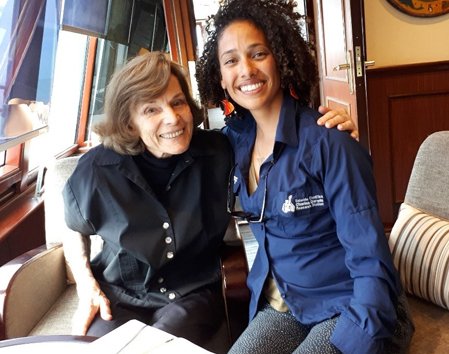
In 2019, we did our first expedition together with the Mission Blue team on the M/V Argo, and headed straight to the newly found kelp forests, giving me the chance to see, survey, and sample this deep-water community in a submarine (more on this expedition here). These samples together with other specimens led us to realize that the kelp was a different and possibly new species, meaning that Galápagos is likely home to two distinct kelp species (Buglass et al 2022). However, to be sure we needed to find a fresh sample of the E. galapagensis, last seen between 2006 and 2010 on the remote and extremely exposed west coastlines of Fernandina and Isabela.
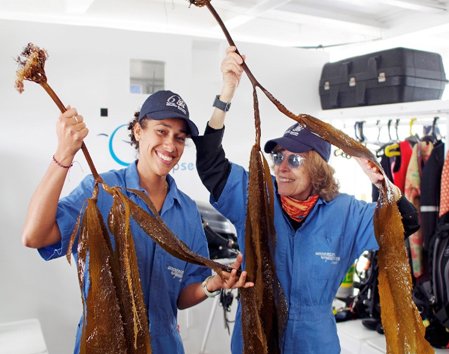
Sylvia was game to help me try to find some living Galápagos kelps. One long pandemic later, in mid-July 2022, we reunited on the M/V Argo, teaming up with a fantastic group of local and international scientists, Galápagos National Park rangers, filmmakers and photographers.
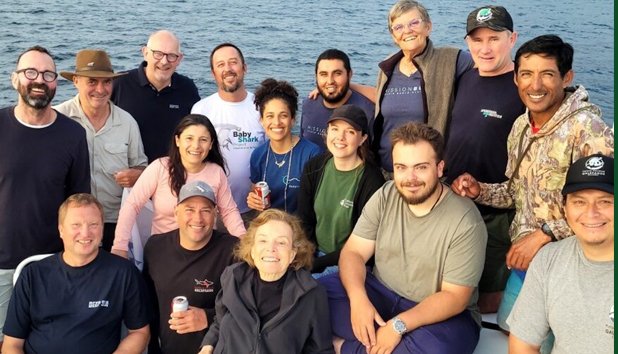
On this Mission Blue expedition, we visited the most remote spots of the archipelago, which meant that I had the chance to look for more deep-water kelp, and if possible, “grab” a specimen. For this I deployed an ROV with a robotic claw, enabling me to do quick deep-water dives down to 50-80m.
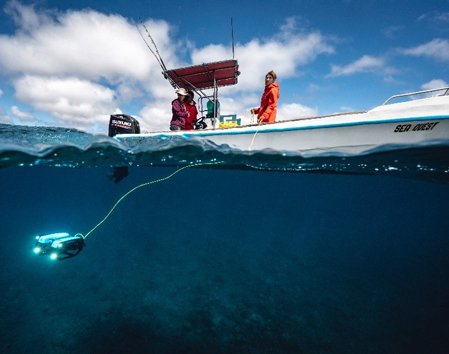
Several times a day the team would ask if I “got kelp?” to which I could only answer “not yet”. Luckily, Sylvia would always give me a reassuring look and reminded everyone to keep their eyes peeled for kelp at all times, be it scuba diving or in the submarine. Finally, we reached Fernandina, the youngest and most westerly island, sitting on a Galápagos geologic hotspot, and the location where the endemic kelp was last seen. I decided this time to look for it at a site called Pedro’s Paradise, on the very exposed, west coast of Fernandina. I took a small team of scuba divers with me on a short vertical dive down to 30m. As I reached the bottom I felt like I was diving off the west coast of Canada, it was cold (~17C), and the sea floor was covered with a lush array of different fleshy macroalgae forming a beautiful bushy carpet with vibrant red, brown and green colors.
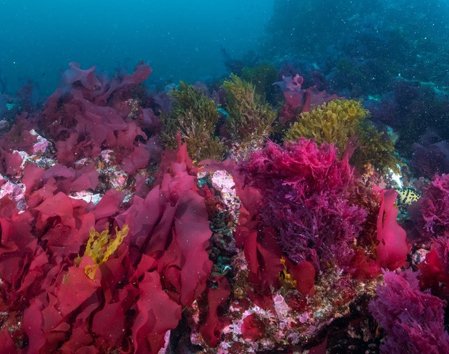
The other divers kept pointing to algae they thought could be kelp. At this stage I knew very well how to distinguish kelp from other brown algae. It took about 15 minutes until voilà, I spotted one then two, and then a few more kelp bushes spread out. I was thrilled but had to stay focused as time was of the essence so I quickly collected a few specimens. As we only had one day at this site, we did a second dive to video survey the site and kelps using a stereo-camera set. We also collected water samples and other macroalgae that cohabit with the kelp.
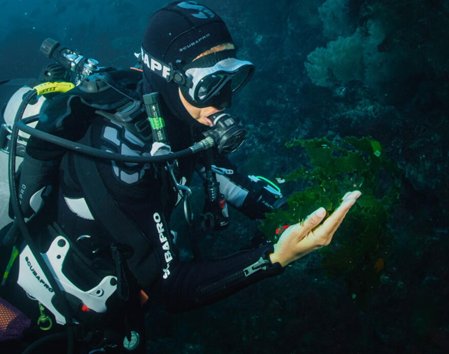
Finally, Taylor, Sylvia’s grandson who is also crazy about kelp, accompanied me to see if we could find kelp deeper using the DeepSee submarine. As the sub can only be launched in calm waters, we could not return to the same site, so I was not sure we would be in luck. As we crept up a submarine wall starting at 180m depth, we encountered the most colorful gorgonian, sponge, and black coral gardens that were so spectacular it looked like a fake aquarium.
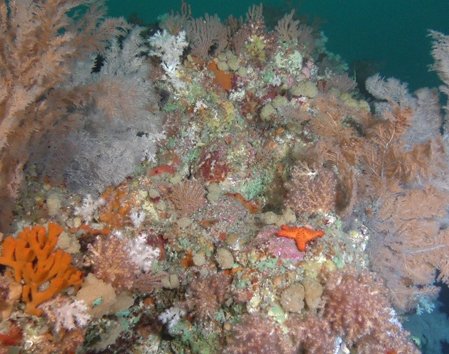
The icing on the cake was when we reached the top of the ledge at 40-30m, which was covered with a dense kelp forest of E. galapagensis. Taylor, Juval (our superb sub-pilot) and I watched in awe as the kelp swayed (or danced) from side to side in the swell, and shoals of fish and the occasional sea lion swam into view.
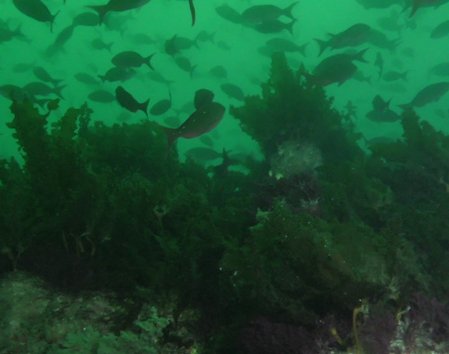
Back on the Argo, Taylor and I wasted no time in processing the fresh kelp samples we collected, which involved inspecting and measuring each kelp, and taking valuable micro-samples from the blades for a genetic study to finally resolve whether we have two different kelp species in the Galápagos. I was lucky again to have Sylvia on board as she is a phycologist (algae scientist) herself, who expertly showed me how to press macroalgae effectively with makeshift gear, which is the best way to preserve them. Sylvia, Taylor and I worked into the night as we only had one more safeguard all the samples. Two days later, we said our goodbyes. Although sad to see the team go, I was nevertheless jubilant as I disembarked with a massive cardboard box in which I carried our kelp specimens, along with an array of water and genetic samples.
Mission accomplished – got kelp!
Part of our samples will soon be shipped to colleagues in Japan who are expert kelp geneticists. They will help us finally resolve whether Galapagos is home to just one kelp species that morphologically can vary greatly, or two species of kelp, one of them being a new species for the region and potentially to science. Our goal is to publish our findings within the next 6 months, so stay tuned.
